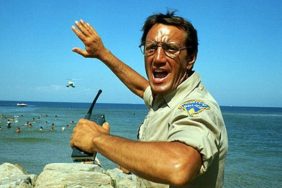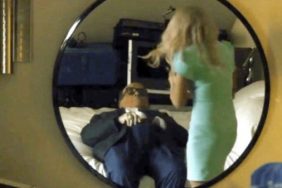Ask most people what their favorite movie is, and they’ll tell you. Ask a film critic, and they’ll probably waffle, say it’s a stupid question, or fall back on a Top 10 list. Well… no longer. Every week at CraveOnline we’re asking our four film critics – William Bibbiani, Witney Seibold, Fred Topel and Brian Formo – to pick The Best Movie Ever, and defend their one and only choice.
January 2014 brings forth a whole slew of “found footage” movies – microbudget motion pictures that are supposedly videotaped entirely by the characters within the movie – including Paranormal Activity: The Marked Ones, Devil’s Due and Best Night Ever. So in our inaugural column, we asked Bibbs, Witney, Fred and Brian to decide which film best represents the relatively young genre. Naturally, there wasn’t a single agreement among them, so it’s up to you to decide who is right, and who is an idiot.
These are their picks for The Best Found Footage Movie Ever.
Witney Seibold:

The very phrase “found footage” is stirring and evocative. It calls to mind the image of undeveloped film canisters, left behind in an abandoned warehouse. Or perhaps grimy reels of 8mm film discovered at a crime scene, and only watched by the FBI. Maybe a grimy VHS tape was found in the woods with bloodstains on it, only to be cleaned off and watched by some curious soul who wants to know the story of how it got there. As such, the “found footage” genre of mockumentary works best when we, the audience, get to see found footage that is somehow dark, criminal, and utterly verboten. If we’re seeing something horrific and violent – a snuff film, in short – the found footage aesthetic only works in its favor, making it more disturbing and horrifying. The violence becomes, for brief flashes, very sickeningly real.
The French classic Man Bites Dog (a “documentary” about a serial killer) nearly topped my list in this regard, but I have to skew a bit more disgusting and cheap with my actual pick, and go with Ruggero Deodato’s 1985 cult film Cannibal Holocaust, quite easily one of the most disgusting movies ever made. Part mockumentary, part legitimate Mondo movie, Cannibal Holocaust is an exploitation movie of the lowest order. It follows an enthused film crew of death-obsessed students deep into the wilds of cannibal territory, where they meet a grisly on-camera fate. Mixed into the convincing gore effects are real shots of animals being killed (yeah, it’s that kind of film), making the entire movie feel like it should be illegal. In an age where it’s difficult to shock and disturb the general populace with a horror movie, and older movies tend to feel stodgy and dated, Cannibal Holocaust is still disgusting. And, well, that’s certainly something to consider in the annals of film history.
Brian Formo:

At the rate these are getting pumped out, has the low budget found footage film become the new monster flick of the 50s and 60s? Director Matt Reeves and producer J.J. Abrams combined our popcorn desire for both films into my choice for best found footage film. Cloverfield has more of a budget than most found footage films, but that’s because it has a monster. The reason why Cloverfield works for me is that the monster is barely visible.
In a time where we are all potential photojournalists when trauma happens, we realize that civilians have a hard time capturing what is going on. Why? Fear, being rushed, being an untrained professional. In that regard, Cloverfield is like a cinema-vérité monster movie. Cloverfield did receive some flack for some close-to-9/11 material involving NYC disaster scenes, and seeing the new promos for Godzilla that appears to be a trend that will continue in monster movies, but in a way that enhances the film for me. Cloverfield takes a palpable fear of attack that many more people have now and plops something otherworldly in its place to reduce our own tensions.
Fred Topel:

I feel like I should pick Apollo 18 to defend my assertion that applying the tropes of found footage to space was clever, however, since then another film truly elevated the genre. The Paranormal Activity series started as a gimmick. Oren Peli took two unknowns and filmed them doing minimal things to create a spooky movie. Once it was a hit, the sequel expanded on the camera footage and the mythology of the Katie (Katie Featherston) story by showing us how the curse affected her extended family. Paranormal Activity 3 is the pièce de résistance.
Going back to the ‘80s, PA3 tells us the story of little Katie and Kristi and their first encounter with paranormal activity. Fortunately, it’s the age of VHS camcorders so their father decides to record everything. Deepening the mythology is always a good thing, but directors Henry Joost and Ariel Schulman (Catfish) thought of inventive ways to use in camera scares. A homemade swivel using a rotating fan lets the camera pan between the kitchen and living room, revealing things in the frame without cutting the camera. There were surely some visual effects, but it’s all made to look practical, like it’s happening before the camera.
Found footage used to be a way for aspiring filmmakers with no production value to justify a rough, amateur production. Paranormal 3 took the reigns and showed show you could use it to elevate the storytelling, though I still think it’s a missed opportunity that Paranormal 4 didn’t go back to the ‘70s with 8mm camera footage.
William Bibbiani:

The “found footage” genre is fundamentally realistic, in that essentially that’s the whole gag, but it’s also fundamentally ludicrous. Why, if someone isn’t necessarily planning to make a documentary out of all this footage (The Blair Witch Project is thusly forgiven), would these people keep on filming when their lives, their most valued relationships, or their sanity is threatened? The tropes that “I don’t know what else to do!” or “People need to know the truth!” have become so tired already that when someone yelled them in the first act of Rec 3: Genesis, the heroes knocked the camera out of the cameraman’s hand, forcing the film to abandon its found footage format and continue like a normal movie. (Incidentally, my honorable mention is Rec 3: Genesis.)
But impressively, Josh Trank’s superhero entry in the found footage genre, 2012’s Chronicle, found multiple ways to explain why the cameras keep rolling, and even turns them off when leaving them on would strain credulity. (Well, mostly.) High schooler Dane DeHaan buys a camera to document his miserable life and increasingly abusive father, but soon he, his cousin Alex Russell and popular jock Michael B. Jordan are exposed to an alien artifact, acquire superhuman powers, and use cameras the way self-involved kids with an inflated sense of their own power often do: to document being assholes and doing cool tricks.
By the time their powers start causing destruction, Dane DeHaan’s sanity is on the brink, the camera begins to focus entirely on him because it’s part of his super-villain M.O., side characters disappear for long swaths because he’s not there to film them, and his private videos play like the manifesto of megalomaniac. Later, when the showstopping, action-packed finale lays waste to a major metropolis, security cameras pick up most of the violence, shifting the audience’s perspective again to that of the helpless “normal” people who would look upon these mighty titans in awe and fear.
Chronicle is a smartly written, finely acted superhero saga that doesn’t just happen to be in the found footage format, it relies on it for style, characterization and context. It rarely feels artificial and never falls back on tacky tropes just to justify its own genre. It may not be typical, but as far as I’m concerned, it’s the best found footage movie the zeitgeist has produced so far.








